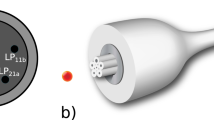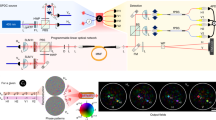Abstract
In a non-reciprocal optical amplifier, gain depends on whether the light propagates forwards or backwards through the device. Typically, one requires either the magneto-optical effect, temporal modulation or optical nonlinearity to break reciprocity. By contrast, here we demonstrate non-reciprocal amplification of fibre-guided light using Raman gain provided by spin-polarized atoms that are coupled to the nanofibre waist of a tapered fibre section. The non-reciprocal response originates from the propagation-direction-dependent local polarization of the nanofibre-guided mode in conjunction with polarization-dependent atom–light coupling. We show that this novel mechanism can also be implemented without an external magnetic field and that it allows us to fully control the direction of amplification via the atomic spin state. Our results may simplify the construction of complex optical networks. Moreover, by using other suitable quantum emitters, our scheme could be implemented in photonic integrated circuits and circuit quantum electrodynamics.
This is a preview of subscription content, access via your institution
Access options
Access Nature and 54 other Nature Portfolio journals
Get Nature+, our best-value online-access subscription
$29.99 / 30 days
cancel any time
Subscribe to this journal
Receive 12 print issues and online access
$209.00 per year
only $17.42 per issue
Buy this article
- Purchase on Springer Link
- Instant access to full article PDF
Prices may be subject to local taxes which are calculated during checkout



Similar content being viewed by others
References
Potton, R. J. Reciprocity in optics. Rep. Prog. Phys. 67, 717 (2004).
Jalas, D. et al. What is–and what is not—an optical isolator. Nat. Photon. 7, 579–582 (2013).
Asadchy, V. S., Mirmoosa, M. S., Díaz-Rubio, A., Fan, S. & Tretyakov, S. A. Tutorial on electromagnetic nonreciprocity and its origins. Proc. IEEE 108, 1684–1727 (2020).
Caloz, C. et al. Electromagnetic nonreciprocity. Phys. Rev. Appl. 10, 047001 (2018).
Sounas, D. L. & Alù, A. Non-reciprocal photonics based on time modulation. Nat. Photon. 11, 774–783 (2017).
Fan, S., Shi, Y. & Lin, Q. Nonreciprocal photonics without magneto-optics. IEEE Antennas Wireless Propag. Lett. 17, 1948–1952 (2018).
Khurgin, J. B. Non-reciprocal propagation versus non-reciprocal control. Nat. Photon. 14, 711 (2020).
Kittlaus, E. A. Reply to ‘Non-reciprocal propagation versus non-reciprocal control’. Nat. Photon. 14, 712 (2020).
Lodahl, P. et al. Chiral quantum optics. Nature 541, 473–480 (2017).
Sayrin, C. et al. Nanophotonic optical isolator controlled by the internal state of cold atoms. Phys. Rev. X 5, 041036 (2015).
Scheucher, M., Hilico, A., Will, E., Volz, J. & Rauschenbeutel, A. Quantum optical circulator controlled by a single chirally coupled atom. Science 354, 1577–1580 (2016).
Lin, G. et al. Nonreciprocal amplification with four-level hot atoms. Phys. Rev. Lett. 123, 033902 (2019).
Ruesink, F., Miri, M.-A., Alu, A. & Verhagen, E. Nonreciprocity and magnetic-free isolation based on optomechanical interactions. Nat. Commun. 7, 13662 (2016).
Fang, K. et al. Generalized non-reciprocity in an optomechanical circuit via synthetic magnetism and reservoir engineering. Nat. Phys. 13, 465–471 (2017).
Shen, Z. et al. Reconfigurable optomechanical circulator and directional amplifier. Nat. Commun. 9, 1797 (2018).
Otterstrom, N. T. et al. Resonantly enhanced nonreciprocal silicon Brillouin amplifier. Optica 6, 1117–1123 (2019).
Krause, M., Müller, J. & Brinkmeyer, E. Measurement of nonreciprocal stimulated Raman scattering in silicon photonic wires. In The 9th International Conference on Group IV Photonics (GFP) 6–8 (IEEE, 2012).
Lawrence, M. & Dionne, J. A. Nanoscale nonreciprocity via photon-spin-polarized stimulated Raman scattering. Nat. Commun. 10, 3297 (2019).
Petersen, J., Volz, J. & Rauschenbeutel, A. Chiral nanophotonic waveguide interface based on spin-orbit interaction of light. Science 346, 67–71 (2014).
Mitsch, R., Sayrin, C., Albrecht, B., Schneeweiss, P. & Rauschenbeutel, A. Quantum state-controlled directional spontaneous emission of photons into a nanophotonic waveguide. Nat. Commun. 5, 5713 (2014).
Bliokh, K. Y., Rodríguez-Fortuño, F. J., Nori, F. & Zayats, A. V. Spin–orbit interactions of light. Nat. Photon. 9, 796–808 (2015).
Vetsch, E. et al. Optical interface created by laser-cooled atoms trapped in the evanescent field surrounding an optical nanofiber. Phys. Rev. Lett. 104, 203603 (2010).
Østfeldt, C. et al. Dipole force free optical control and cooling of nanofiber trapped atoms. Opt. Lett. 42, 4315–4318 (2017).
Markussen, S. B. et al. Measurement and simulation of atomic motion in nanoscale optical trapping potentials. Appl. Phys. B 126, 73 (2020).
Brion, E., Pedersen, L. H. & Mølmer, K. Adiabatic elimination in a lambda system. J. Phys. A 40, 1033 (2007).
Meng, Y., Dareau, A., Schneeweiss, P. & Rauschenbeutel, A. Near-ground-state cooling of atoms optically trapped 300 nm away from a hot surface. Phys. Rev. X 8, 031054 (2018).
Dareau, A., Meng, Y., Schneeweiss, P. & Rauschenbeutel, A. Observation of ultrastrong spin-motion coupling for cold atoms in optical microtraps. Phys. Rev. Lett. 121, 253603 (2018).
Guerin, W., Michaud, F. & Kaiser, R. Mechanisms for lasing with cold atoms as the gain medium. Phys. Rev. Lett. 101, 093002 (2008).
Braak, D. & Mannhart, J. Fermi’s golden rule and the second law of thermodynamics. Found. Phys. 50, 1509–1540 (2020).
Loos, S. A. M. & Klapp, S. H. L. Irreversibility, heat and information flows induced by non-reciprocal interactions. New J. Phys. 22, 123051 (2020).
Clerk, A. A., Devoret, M. H., Girvin, S. M., Marquardt, F. & Schoelkopf, R. J. Introduction to quantum noise, measurement, and amplification. Rev. Mod. Phys. 82, 1155 (2010).
Gu, X., Kockum, A. F., Miranowicz, A., Liu, Y. & Nori, F. Microwave photonics with superconducting quantum circuits. Phys. Rep. 718–719, 1–102 (2017).
Kien, F. L., Liang, J., Hakuta, K. & Balykin, V. Field intensity distributions and polarization orientations in a vacuum-clad subwavelength-diameter optical fiber. Opt. Commun. 242, 445–455 (2004).
Schlosser, N., Reymond, G. & Grangier, P. Collisional blockade in microscopic optical dipole traps. Phys. Rev. Lett. 89, 023005 (2002).
Vetsch, E. et al. Nanofiber-based optical trapping of cold neutral atoms. IEEE J. Sel. Top. Quantum Electron. 18, 1763–1770 (2012).
Sayrin, C., Clausen, C., Albrecht, B., Schneeweiss, P. & Rauschenbeutel, A. Storage of fiber-guided light in a nanofiber-trapped ensemble of cold atoms. Optica 2, 353–356 (2015).
Fleischhauer, M., Imamoglu, A. & Marangos, J. P. Electromagnetically induced transparency: optics in coherent media. Rev. Mod. Phys. 77, 633 (2005).
Johansson, R. J., Nation, P. D. & Nori, F. QuTiP 2: a Python framework for the dynamics of open quantum systems. Comput. Phys. Commun. 184, 1234–1240 (2013).
Pucher, S., Liedl, C., Jin, S., Rauschenbeutel, A. & Schneeweiss, P. Atomic spin-controlled non-reciprocal Raman amplification of fibre-guided light. Zenodo https://zenodo.org/record/6242113 (2022).
Acknowledgements
We thank J. Fink, A. Husakou, F. Tebbenjohanns and J. Volz for stimulating discussions and helpful comments. We acknowledge funding by the Alexander von Humboldt Foundation in the framework of the Alexander von Humboldt Professorship endowed by the Federal Ministry of Education and Research. Moreover, financial support from the European Union’s Horizon 2020 research and innovation programme under grant agreement no. 800942 (ErBeStA) is gratefully acknowledged.
Author information
Authors and Affiliations
Contributions
C.L. and S.P. adapted and extended the setup for this experiment and carried out the measurements. S.J. assisted in the early stages of the experiments. Data were analysed and modelled by C.L., S.P. and P.S. The experiment was conceived and supervised by A.R. and P.S. All the authors contributed to the writing of the manuscript.
Corresponding author
Ethics declarations
Competing interests
The authors declare no competing interests.
Peer review
Peer review information
Nature Photonics thanks Kanu Sinha, David Wilkowski and the other, anonymous, reviewer(s) for their contribution to the peer review of this work.
Additional information
Publisher’s note Springer Nature remains neutral with regard to jurisdictional claims in published maps and institutional affiliations.
Supplementary information
Supplementary Information
Supplementary Figs. 1–9, Discussion and Table 1.
Rights and permissions
About this article
Cite this article
Pucher, S., Liedl, C., Jin, S. et al. Atomic spin-controlled non-reciprocal Raman amplification of fibre-guided light. Nat. Photon. 16, 380–383 (2022). https://doi.org/10.1038/s41566-022-00987-z
Received:
Accepted:
Published:
Issue Date:
DOI: https://doi.org/10.1038/s41566-022-00987-z
This article is cited by
-
Non-reciprocal topological solitons in active metamaterials
Nature (2024)
-
An atomic spin on amplification of light
Nature Photonics (2022)
-
Atomic spin-controlled non-reciprocal Raman amplification of fibre-guided light
Nature Photonics (2022)



